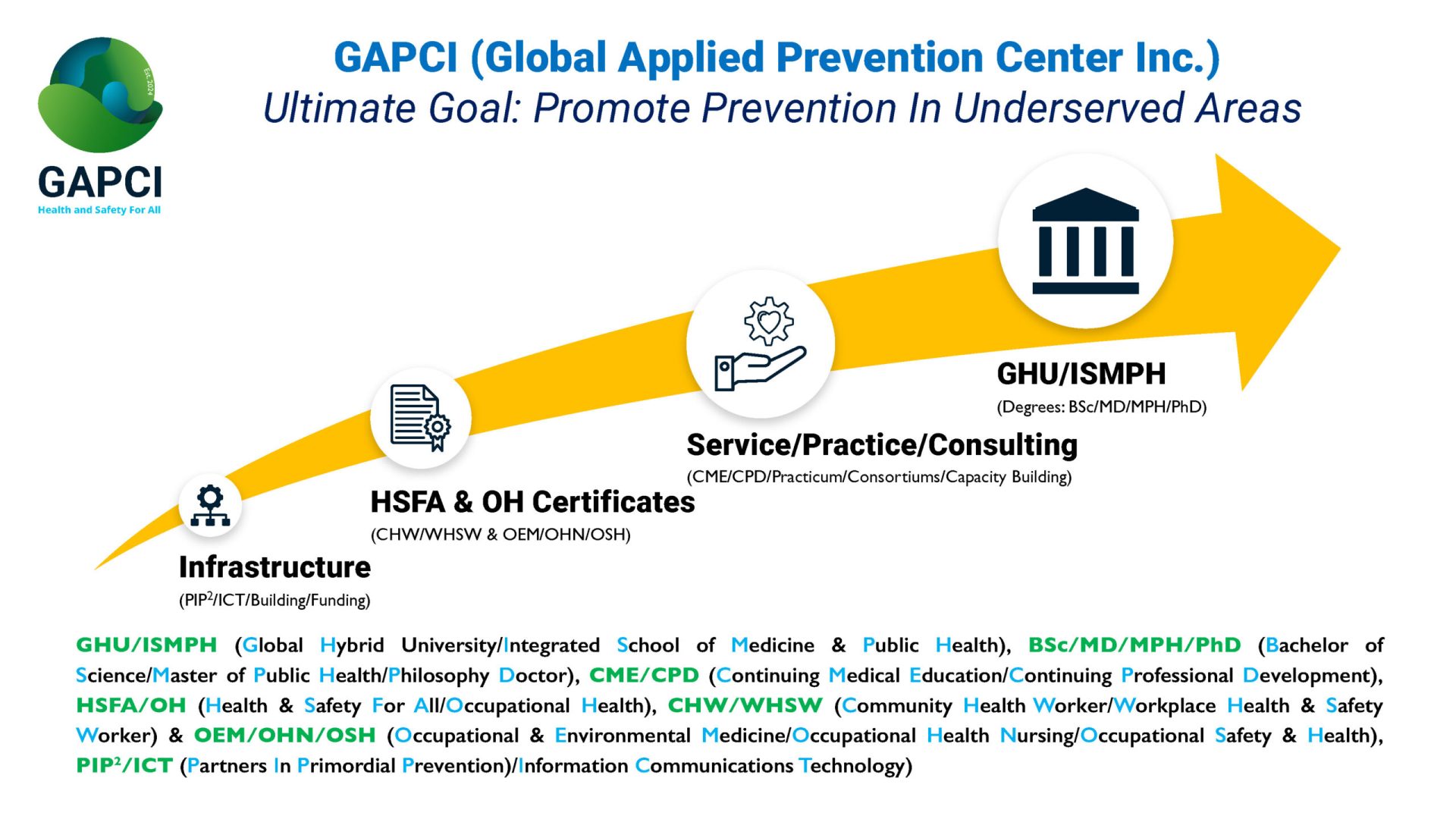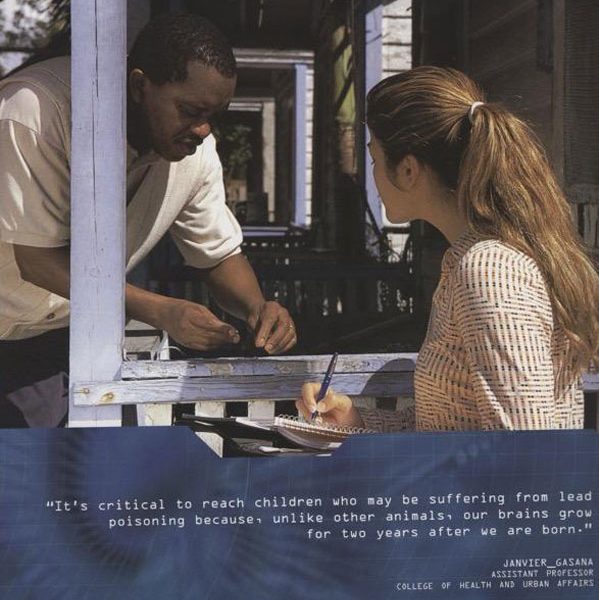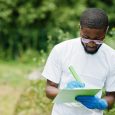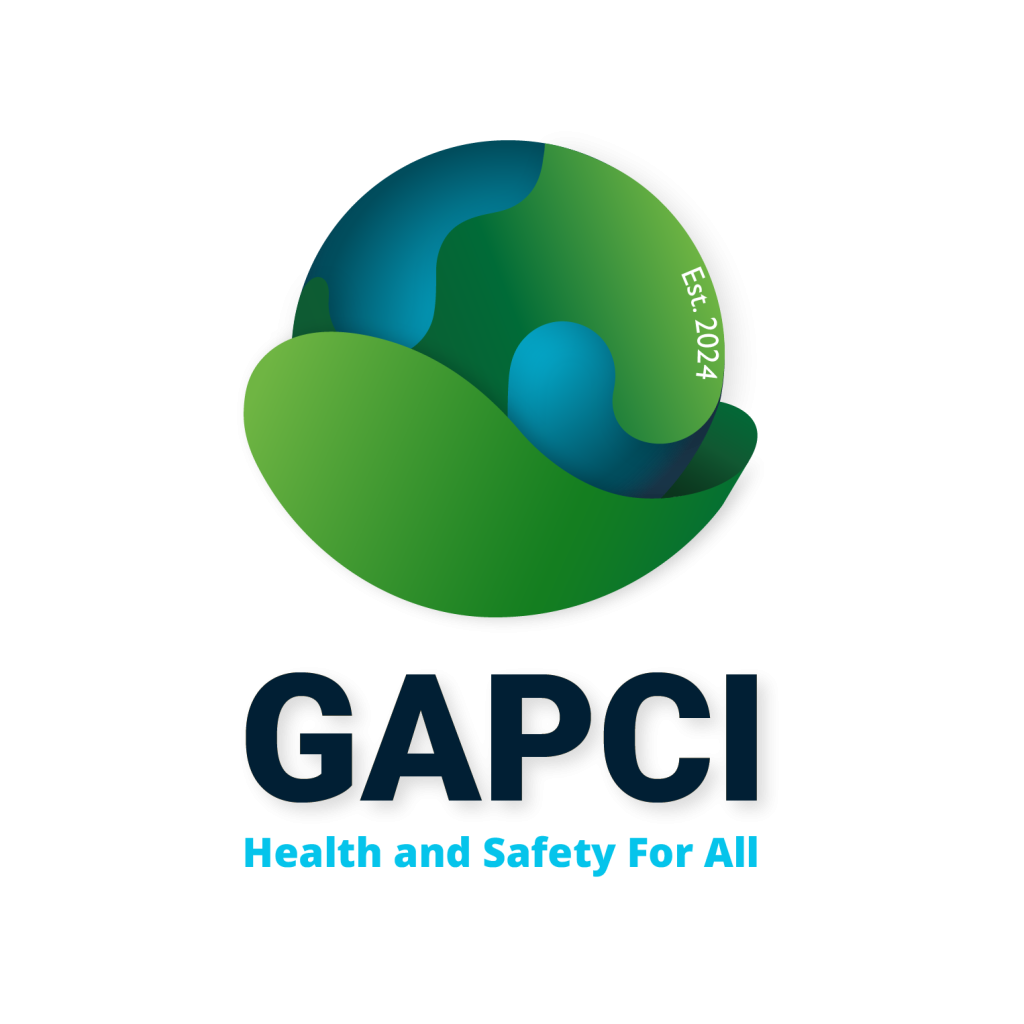
In essence to develop evidence-based solutions for global public health challenges by collaborating with governments, academic, medical, and community organizations around the world.
GAPCI will engage community health workers (CHWs), workplace health and safety workers (WHSWs), health professionals and other stakeholders to promote individual and community-based responses to occupational and environmental health issues.
GAPCI will recognize, respect, and rely on local knowledge and lived experiences –to build trust, to rely on the fifth wave in public health that requires shared responsibilities for healthier behavior, valuing and adopting healthy lifestyles.
Our firm belief in health as a human right and the right to science will be the guiding efforts of the center.
GAPCI believes in the empowerment of the community with the help of CHWs, WHSWS, and health professionals. The focus of the center is to develop and implement targeted evidence-based prevention strategies for the residents living in underserved areas. GAPCI will start small with initiatives in US urban and rural areas and worldwide including slums /shanty towns in Africa, Caribbean/Latin America, and Asia. As public health professionals at GAPCI, we always ought to start with what people already know and/or do share the life experience of those we want to work with and/or organize.
GAPCI serves under-served populations regarding public health challenges by working with community health workers, workplace health and safety workers, and global partners in primordial prevention, encouraging people to value their health more highly, helping them to make healthy choices more easily, reducing the ways in which unhealthy lifestyles are promoted, and recognizing that we all have a role in supporting others to adopt a healthy lifestyle.

Primordial prevention focuses on emergence of risk factors, such as unhealthy behaviors or environmental and/or occupational conditions, rather than just treating diseases that result from them.
Lead came at the forefront of this exposure when people discovered lead’s unique properties, such as its high density (heavy metal), malleability, and ability to resist corrosion.
1. Primordial Prevention: Preventing the source of lead contamination from entering the environment and from leaving the premise of the workplace while protecting the workers.
2. Primary Prevention: Preventing lead exposure in the population and in the workers.
3. Secondary Prevention: Early detection and intervention for individuals already exposed to lead.
4. Tertiary Prevention: Managing and reducing the effects of lead poisoning in individuals.
5. Quaternary Prevention: Avoid over-medicalization and unnecessary treatment.
o Miner – Jose, a smelter, worked for a lead smelting company. He used the personal protective equipment at work. He somehow didn’t always take a shower nor change clothes before heading home. So, he ended up bringing lead dust home to his family.
o Home – Also, his family of four lived in an old home that was built in 1950s in an old part of a large city. They had no idea that their home’s old paint and pipes were contaminating their air and water.
o Play and Exposure – His children played with toys and crawled on floors contaminated with lead dust from Jose’s clothes and shoes. They tried his clothes on from time to time. They played also in the front and backyard that had a lot of dust. While doing laundry, his wife was exposed to lead dust from Jose’s work clothes. Also, Jose’s own health was at risk due to extensive exposure to lead at work.
o Diagnosis – Jose’s children were diagnosed with developmental delays, learning disabilities, and behavioral problems due to exposure to lead. His wife had miscarriages and infertility issues. Jose developed kidney damage, high blood pressure, and memory loss.
o Correlation between environmental and biological assessments – The environmental assessment revealed high lead levels in the dust in the living room, bedrooms, the front and the backyard. There was a correlation between the environmental lead levels and blood lead levels from all the members of the family.
o Lesson – Take-home lead poisoning and lead poisoning from the inside and outside of an old home constitute real health risk for families. In this scenario, the family is confronted with 1) lead from the workplace and the clothes that the father took home and 2) lead in the home’s environment that came from old lead-based paint and lead-contaminated soil and dust from the city’s major streets (due to the legacy from the leaded gasoline).
o Prevention – Prevention is the only key, especially primordial prevention that would have prevented the source of lead contamination from entering the environment (if our society did not add lead in gasoline, paint, and other products) and from leaving the premise of the workplace while protecting the workers. Healthy diet that has a high content of calcium, iron and other essential minerals goes along of way to prevent lead poisoning.
o While in graduate school in Chicago in early 1990s, Prof Gasana was part of a team that collected samples of soil and dust along highways and major streets in Chicago, took them to the lab, and analyzed them for lead.
o In mid-1990s, Prof Gasana, his colleagues, his graduate students, and Community Health Workers (CHWs) that he hired received support to conduct a pilot study using funds he raised from a nonprofit organization (FAECLP – Florida Alliance to Eradicate Childhood Lead Poisoning, with the help of FIU (Florida International University) Sponsored Research Division.
o In the mid-2010s, he did consulting work for the World Bank in the Democratic Republic of Congo (DRC) that assessed the impact of mining on miners, surrounding populations, and the environment. The work uncovered heavy contamination of the environment by toxic heavy metals that included lead, mercury and others.
o He taught “Advanced Waterborne Diseases” to PhD students majoring in Water and Public Health in Ethiopia. The course emphasizes the crucial importance of WASH (Water Sanitation Hygiene) and the 8 Fs (1. Feces / 2. Fluids / 3. Fingers / 4. Flies
/ 5. Fields / 6. Floods / 7. Food / 8. Faces) of WASH barrier of waterborne disease transmission in preventing communicable diseases (especially diarrheal diseases).
o He conducted a two-week workshop of OSH (Occupational Safety and Health) for young Haitian entrepreneurs who were funded by USAID for their business of soap making, bakery, chicken farms, and others. GAPCI board member, Phil Hagan provided him with a lot of teaching materials form his OSH books he publishes under the National Safety Council.
o He then moved to Kuwait University (KU) where he served as founder/inaugural EOH (Environmental and Occupational Health) department chair and
MPH (Master of Public Health) program director and he replicated that Miami lead poisoning study in Kuwait.
o At KU, he taught Public Health Biology to non-health major MPH students at Kuwait University. This course is designed to assist students in public health in their understanding of the pathogenesis of various disease conditions (especially NCDs) and to identify critical points in the aging process at which such pathogenesis could either be prevented or interrupted (Primordial prevention that targets major modifiable risk factors is strongly recommended, especially when it focuses on the young people).
o All of this work led to the idea of establishing GAPCI (Global Applied Prevention Center Inc.).
o Prof Gasana strives to practice what he preaches using the 12 Ss
1. Serenity (Psychological Wellbeing/Stress Management/Mindfulness)
2. Sugar/Salt Limited Consumption
3. Smoking Cessation/Tobacco Control
4. Spirits/Alcohol Limited Consumption
5. Sleep (7-8 hours)
6. Sports/Physical Activity
7. Salad/Healthy Diet
8. Safety /Environmental Changes/Collective Efficacy
9. Shots/Vaccination / Regular Checkups/Health Education
10. Site-Specific Engagement (Community- & Workplace-Employee-Engagement)
11. Social Support /Collective Efficacy
12. Supplements when indicated by the lab test).
For #6. Sports, he does a 30+-minute whole body workout every morning (shine or rain). On November 27, 2023, Al Nahil Int’l Clinic in Kuwait did a physical examination and a body composition analysis and found out that Prof Gasana had a metabolic age of 57 years while his biological age was 67 years.
o Three of us as GAPCI board members strongly believe in the cost-effectiveness of primordial prevention to tackle NCDs and CDs. Prof Gasana (Janvier) met Phil (Hagan) while they were both serving on the Editorial Advisory Board of the National Safety Council (NSC) and they started brainstorming about GAPC. Chamberlain (Diala), Phil’s friend and classmate from the MPH program at George Washington University joined GAPCI as founding board member also after earning a PhD degree from Johns Hopkins University.
o Thus, we urge you all to join us at GAPCI as PIP2, donors, and/or volunteers. All work will be done using a hybrid format (online for training/teaching, research, and service by selected outstanding experts in health, public health, and primordial prevention and onsite for practicum, teaching, research, and service by PIP2 in the regional PIP2 hubs.


Founder and Chair
Janvier Gasana, MD, MPH, PhD, is the CEO of GAPCI in South Florida United States of America.
Prof Gasana (fondly called “Prof G” by his students) is respected worldwide in the area of public health/occupational health and medicine.
He has a background of a clinician, a scholar, an applied public health researcher and practitioner, a seasoned university educator and administrator and most importantly a strong believer in partnership to put to good use his vast knowledge to work with the underserved corners of our world. He has a distinguished career in establishing and leading Environmental and Occupational Health programs at institutions like FIU (Florida International University) and Kuwait University and now GAPCI.

Secretary
Phil Hagan, JD, MBA, MPH, is a seasoned attorney and risk management consultant with 30 years of experience advising diverse industries globally, lecturing at top universities, and leading International Risk Management, LLC on projects across multiple countries.

Treasurer
Chamberlain Diala, PhD, MPH, is the Director of Technical Infectious Diseases and Health Systems at FHI 360 in Washington DC, with expertise in HIV mitigation, local capacity development, and community health workforce development, and is known for his leadership and cross-cultural skills in complex environments.

Advisory Technology (ICT)/ PIP2

Program and Research Evaluation

Marketing/ Communication and Funding

Policy/ Advocacy and Engagement

Ethics Quality Assurance and Audit

The Global Applied Prevention Center Inc (GAPCI) partners with governments, academia, and community organisations to promote public health and safety.